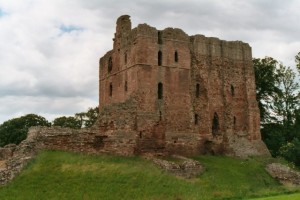Early Life
Daughter of Arnold, Duke of Gueldres (Guelders), and Catherine of Cleves, Mary (Marie) was also the great-niece of Philip, Duke of Burgundy. Mary came to the Burgundian court when she was about twelve and was soon one of the attendants for Princess Catherine, the first wife of Charles (who would later marry Margaret of York). The Burgundian court was renowned for its sophistication, and Duke Philip was a patron of musicians and artists.
In 1446, James II’s ambassador came to Gueldres, likely to talk about a possible marriage between James and Mary. In the next year, more envoys came to Burgundy. Following protracted negotiations, an agreement was finally reached in 1449. As part of the contract, Duke Philip was to pay Mary’s dower.
Wedding and Marriage
A large escort, including the Lord of Veere and a fleet of fourteen ships, escorted Mary to Scotland. On the morning of the wedding, a large procession accompanied her to Holyrood Abbey, where James II met her. They went inside to kneel at the high altar for the nuptial Mass. Following mass, Mary was taken into a side chapel, where Rosalind Marshall believes she was dressed in robes of violet crimson, trimmed with ermine. Her coronation and an extravagant banquet followed.
Mary and James had a successful marriage and several children. The future heir, James III, was born in 1451. In addition to their four sons, Mary and James had two daughters, Mary and Margaret.
It was soon after his marriage that James II made some changes in his government. Some sources credit Mary with his repudiation of the Livingston family, who had effectively controlled the government through most of James II’s minority. After his marriage, James began to take steps to loosen their control. Sir Robert Livingstone and Alexander, the son of Sir Alexander Livingstone, were executed. Mary was also present at James’s first Parliament as his own man. It seems obvious that she did have some influence with her husband.
Regency
While leading a siege on Roxburgh Castle, James II could not resist trying out a new gun. It exploded and the king received a mortal wound. Within a week Mary had brought James III to Roxburgh, which the Scottish succeeded in taking. The new king’s coronation was held at Kelso, and Mary received official custody of the young king with the aid of a regency council. Soon afterwards, Mary founded the Collegiate Church of the Holy Trinity in perpetual memory of her husband, as well as all the kings and queens of Scotland. She planned to be buried there. A map in the seventeenth century shows its location
Mary and the Wars of the Roses
Mary’s policy in the Wars of the Roses was shrewd. She received Margaret of Anjou in 1460 and there was some discussion of a betrothal between one of Mary’s daughters and Edward, Prince of Wales. Following the Yorkist victory at Towton, Margaret of Anjou again fled to Scotland, this time accompanied by Henry VI, Prince Edward, and the Dukes of Somerset and Exeter. A shrewd negotiator, Mary convinced the Lancastrians to cede Berwick to Scotland. She also wrested a promise to cede Carlisle.
The Lancastrians stayed at the court for a year, but Mary, partly under the influence of Duke Philip, finally decided to oust them from the court. Once the Lancastrians were gone, Mary met with Earl of Warwick at Dumfries. She may have even proffered a possible marriage between herself and Edward IV. The negotiations did not go far. Margaret of Anjou returned to Scotland and James III, Mary, and the Lancastrian party led an attack on Norham Castle, which was a spectacular defeat. Margaret of Anjou left Scotland, and soon afterwards Mary fell ill. She died in December 1463.
Legacy
In later generations Mary was accused of affairs with Edmund, Duke of Somerset, and Adam Hepburn. It is doubtful that she had the affairs, as contemporary sources do not mention them. She should be better known for her collegiate church, her charitable donations, her shrewd policy of playing the Lancastrians against the Yorks and her building of Ravenscraig Castle in Fife.
Sources:
Charters and documents relating to the Collegiate Church and Hospital of the Holy Trinity, and the Trinity Hospital, Edinburgh (Accessed online, https://archive.org/details/chartersdocument18trin)
Marshall, Rosalind K. Scottish Queens: 1034-1714 (Tuckwell Press: 2003)
Marwick, Sir James D. The history of the Collegiate Church and Hospital of the Holy Trinity and the Trinity Hospital, Edinburgh, 1460-1661 (Accessed online, https://archive.org/details/historyofcollegimarw)
Norman Macdougall, ‘Mary (d. 1463)’, Oxford Dictionary of National Biography, Oxford University Press, 2004 [http://www.oxforddnb.com/view/article/18249, accessed 25 Jan 2015]




